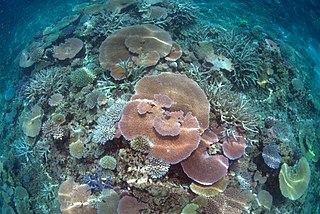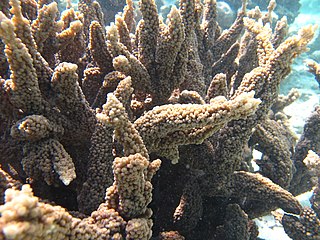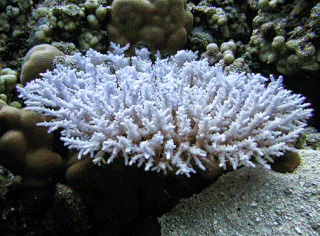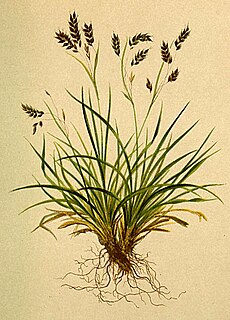
Acropora is a genus of small polyp stony coral in the phylum Cnidaria. Some of its species are known as table coral, elkhorn coral, and staghorn coral. Over 149 species are described. Acropora species are some of the major reef corals responsible for building the immense calcium carbonate substructure that supports the thin living skin of a reef.

The smooth hawksbeard, Crepis capillaris, is a species of flowering plant in the dandelion tribe within the sunflower family, native to Europe. It has become naturalized in other lands and is regarded as a weed in some places.

The staghorn coral is a branching, stony coral with cylindrical branches ranging from a few centimetres to over two metres in length and height. It occurs in back reef and fore reef environments from 0 to 30 m depth. The upper limit is defined by wave forces, and the lower limit is controlled by suspended sediments and light availability. Fore reef zones at intermediate depths 5–25 m (16–82 ft) were formerly dominated by extensive single-species stands of staghorn coral until the mid-1980s. This coral exhibits the fastest growth of all known western Atlantic fringe corals, with branches increasing in length by 10–20 cm (3.9–7.9 in) per year. This has been one of the three most important Caribbean corals in terms of its contribution to reef growth and fishery habitat.

Acropora abrotanoides is a species of acroporid coral found in Indo-Pacific waters from the Red Sea and the Gulf of Aden east to the East China Sea, Japan, the central Pacific Ocean and Australia. It is found in shallow coral reefs that are exposed to the action of strong waves, at depths up to 15 m. It is vulnerable to coral bleaching, disease and crown-of-thorns starfish. It is resistant to predation as it has well-developed radial corallite lips.

Acropora hyacinthus is a species of acroporid coral found from the Indian Ocean, the Indo-Pacific waters, southeast Asia, Japan, the East China Sea and the western Pacific Ocean. It lives on shallow reefs on upper reef slopes, and is found from depths of 1–25 m. Crown-of-thorns starfish preferentially prey upon Acropora corals. It was described by Nemenzo in 1971.

Acropora muricata, commonly called staghorn coral, is a species of acroporid coral found in the Gulf of Aden, the Red Sea, Indian Ocean, Persian Gulf, Australia, central Indo-Pacific, Japan, Southeast Asia, the East China Sea and the oceanic central and western Pacific Ocean. It is found in tropical shallow reefs, slopes of reefs, and in lagoons, from depths of 5 to 30 m. It was described by Dana in 1846.
Acropora abrolhosensis is a species of acroporid coral that was first described by John Veron in 1985. Found in sheltered lagoons and shallow reefs, it is listed as a vulnerable species on the IUCN Red List. The population of the species is decreasing, and most specimens are found in Western Australia, but occurs in many other areas. It is also listed under CITES Appendix II.

Acropora anthocercis is a species of acroporid coral that was first described by G. Brook in 1893. Found on the top slopes of reefs, it is often in contact with strong waves. The species is rated as vulnerable on the IUCN Red List, with a decreasing population covering a large range, but is abundant in some areas such as Queensland. It is also listed under CITES Appendix II.
Acropora awi is a species of acroporid coral that was described by Wallace and Wolstenholme in 1998. Found in fringing reefs, the slopes of shallow reefs, and sandy slopes, it occurs in a marine environment. The species is rated as vulnerable on the IUCN Red List, with a decreasing population, and is easily damaged. It can be found over a large area but is not abundant.
Acropora caroliniana is a species of acroporid coral that was first described by Nemenzo in 1976. Found in tropical, shallow reef slopes, it occurs at depths of 5 to 25 m in a marine environment. The species is rated as vulnerable on the IUCN Red List, with a decreasing population. It is rare, but has been found over a large area, and two-thirds of the regions of Indonesia.
Acropora desalwii is a species of acroporid coral that was first described by Dr Carden Wallace in 1994. Found in sheltered, tropical, shallow reefs, mainly on the slopes, this species is generally found at depths below 15 metres, but this can be as low as 30 metres. The species is rated as vulnerable on the IUCN Red List, with a decreasing population, and is affected by disease. It is common and found over a large area, and is listed under CITES Appendix II.
Acropora elegans is a species of acroporid coral that was first described by Henri Milne-Edwards in 1860. Found in sheltered, sloping reefs, this species occurs at 30 to 60 m depth. The species is listed as vulnerable on the IUCN Red List, and has a decreasing population. It is not common and has a small range, and is listed under CITES Appendix II. It is more resistant to disease than other Acropora species.

Acropora hemprichii is a species of acroporid coral that was first described by Christian Gottfried Ehrenberg in 1834. Found in shallow reefs in marine environments, this species occurs at depths of 3 to 15 m, and lives for between 13 and 24 years. The species is listed as vulnerable on the IUCN Red List, and has a decreasing population. It is common with a wide range, and is listed on Appendix II of CITES.
Acropora hoeksemai is a species of acroporid coral that was first described by Dr. Carden Wallace in 1997. Found in shallow reefs in a marine environment, it is found at depths of 8 to 20 m. It is listed as a vulnerable species on the IUCN Red List, and has a decreasing population. It is common, listed on Appendix II of CITES, and is found over a large range.
Acropora loisetteae is a species of acroporid coral that was first described by C. C. Wallace in 1994. Found in marine, tropical, shallow reefs in sheltered lagoons, it is found at depths between 1 and 30 m. It is listed as vulnerable on the IUCN Red List, and it is thought to have a decreasing population. It is not common but found over a large area, and is listed under CITES Appendix II.

Acropora paniculata is a species of acroporid coral that was first described by Addison Emery Verrill in 1902. Found in marine, tropical, shallow reefs on the upper slopes, it occurs at depths of between 10 and 35 m. It is classed as a vulnerable species on the IUCN Red List, and it has a decreasing population. It is uncommon but found over a large area, including in five regions of Indonesia, and is classified under CITES Appendix II.
Acropora pharaonis is a species of acroporid coral that was first described by Milne-Edwards and Haime in 1860. Found in marine, tropical, reefs on slopes sheltered from wave action, it occurs at depths of between 5 and 25 m. It is classed as a vulnerable species on the IUCN Red List, and it has a decreasing population. It is common and found over a large area and is classified under CITES Appendix II.

Acropora polystoma is a species of acroporid coral that was first described by G. Brook in 1891. Found in marine, tropical, reefs on upper slopes where waves are strong, it occurs at depths between 3 and 10 m. It is classed as a vulnerable species on the IUCN Red List, and it has a decreasing population. It is not common and found over a large area and is classified under CITES Appendix II.

Carex capillaris, the hair-like sedge, is a species of sedge found in North America and northern Eurasia including Greenland.











